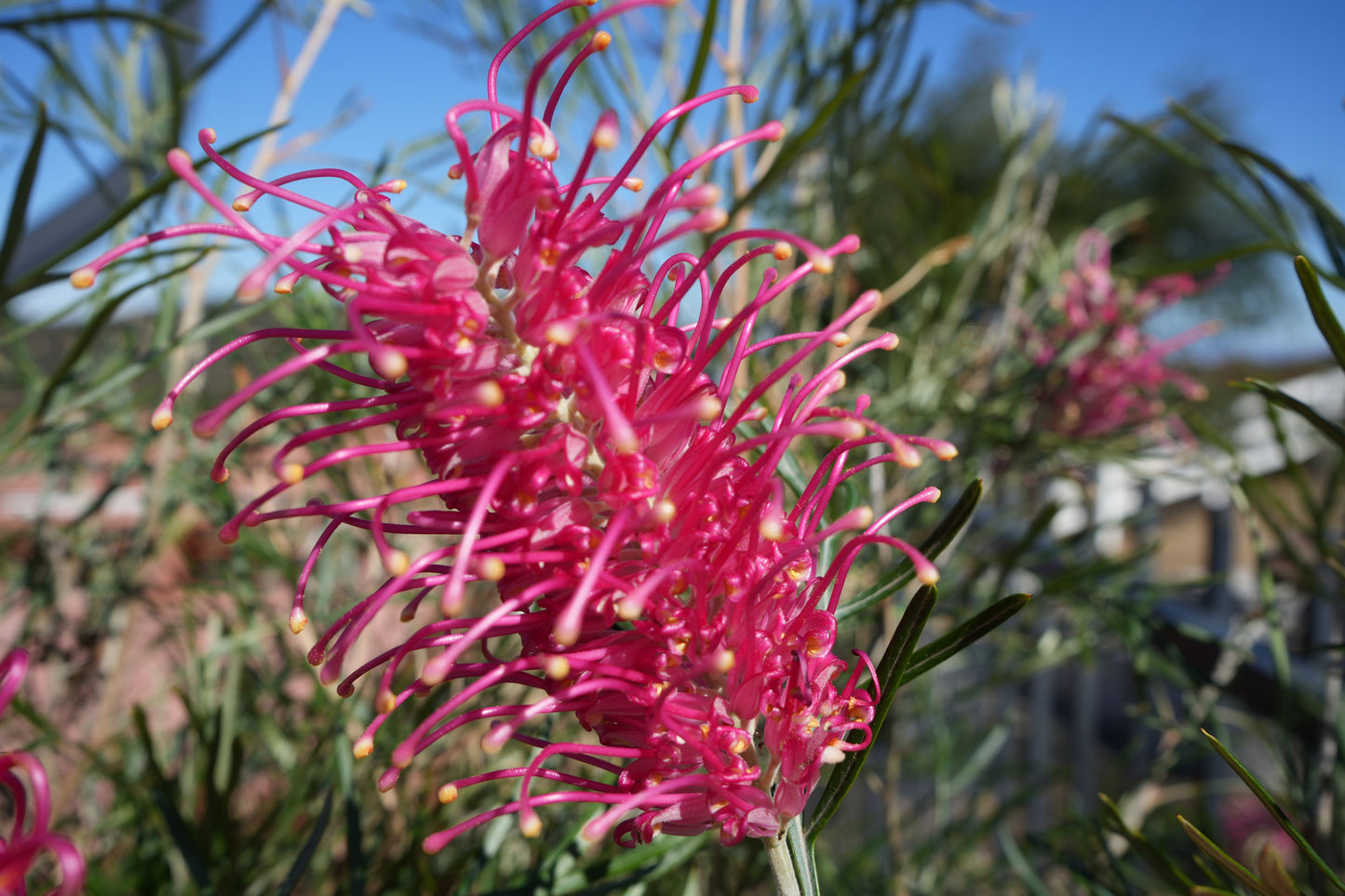Bonte Farm
Grevillea ‘Sylvia’: Vibrant Rosy-Pink Year-Round Bloomer | Hardy Australian Bird Attractor
Grevillea ‘Sylvia’: Vibrant Rosy-Pink Year-Round Bloomer | Hardy Australian Bird Attractor
Couldn't load pickup availability
🌸 Grevillea ‘Sylvia’ - The Year-Round Rosy-Pink Showstopper
Grevillea ‘Sylvia’ is an exceptional, evergreen Australian native shrub renowned for its spectacular, large, and deep rosy-pink to reddish-pink flowers that bloom profusely for most of the year. A popular and reliable cultivar, it brings a vibrant, tropical flair and a magnificent display of color to any garden. With its handsome, deeply divided, silvery-grey to dark-green foliage and low-maintenance nature, 'Sylvia' serves as a superb screening plant, feature specimen, or a brilliant addition to a native or low-water garden. Its striking form and continuous bloom make it a sought-after plant for both experienced and novice gardeners looking for a hardy, bird-attracting focal point.
Botanical Characteristics
- Scientific Name: Grevillea ‘Sylvia’
- Common Names: Grevillea, Spider Flower (a common name for the genus)
- Growth Habit: A dense, upright, and bushy evergreen shrub. It is a progeny of Grevillea 'Misty Pink' (a hybrid of G. banksii and G. sessilis).
- Foliage: Features attractive, deeply divided, fern-like leaves that are often a soft, silvery-grey to dark-green. New growth can exhibit a bronze sheen in cooler weather, adding seasonal interest.
- Flowers: The flowers are borne in large, cylindrical racemes (dense clusters) up to 6 inches long. The vibrant, deep rosy-pink to reddish-pink color is highly showy and provides year-round visual impact.
- Flowering Season: Profuse flowering throughout the year, with peak blooms often occurring from late fall through spring in warmer climates.
Mature Size
- Grevillea ‘Sylvia’ typically grows to a height of 8-12 feet (2.4–3.6 meters) and a spread of 6-8 feet (1.8–2.4 meters). Its vigorous, upright habit makes it a perfect choice for screening and hedging.
USDA Hardiness Zone
- This cultivar is best suited for USDA Hardiness Zones 9–11, as it is sensitive to prolonged hard freezes. It is tolerant of light to moderate frosts once established and performs well in warm, mild climates.
Cultivation and Care
- Sunlight: Thrives in full sun (at least 6 hours of direct sunlight per day) but can tolerate light or partial shade.
- Soil: Demands well-drained soil and will tolerate a range of soil types, including sandy or loamy soils. Acidic to neutral pH is preferred. It is highly intolerant of wet feet and poor drainage, which can lead to root rot.
- Water: Requires regular watering during its establishment period. Once established, it is moderately drought-tolerant and thrives in low-water gardens, needing only occasional deep watering during extended dry spells.
- Fertilizer: Absolutely avoid high-phosphorus fertilizers. Like other Proteaceae, this plant is sensitive to phosphorus. Use a specialized low-phosphorus fertilizer formulated for Australian native plants or none at all, as it often extracts sufficient nutrients from the soil.
- Pruning: Benefits from hard pruning after peak flowering to maintain a compact shape and encourage denser growth. Cutting back by one-third to one-half is well tolerated.
Landscape Use
- Feature Plant: Its bold flowers and elegant foliage make it a stunning focal point or specimen.
- Screening and Hedging: Its dense, upright growth habit is excellent for privacy screens and substantial hedges.
- Cut Flowers: The large, vibrant blooms are highly valued for long-lasting floral arrangements.
- Low-Water/Native Gardens: A robust and ideal choice for xeriscaping and native plant landscapes.
Wildlife Attraction
- The abundant, nectar-rich flowers are a major draw, making the plant a crucial component of a wildlife-friendly garden. It is a magnet for nectar-feeding birds (particularly hummingbirds and honeyeaters) and attracts bees and butterflies.
Pest and Disease Resistance
- Grevillea ‘Sylvia’ is generally a hardy and robust plant that is resistant to most common pests. The primary threat is fungal root rot, which is easily prevented by ensuring excellent soil drainage and avoiding overwatering.
Propagation
- To ensure the resulting plant is true to type and maintains the cultivar's specific characteristics, propagation by semi-hardwood cuttings is the highly preferred method. Cuttings are best taken in late spring to summer. Seed propagation is possible but may not be true to the parent plant.
Share


FAQs
Got a question? We are here to answer


